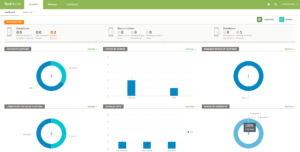
Monitor a XenMobile infrastructure part 1.
A lot of things can be monitored in XenMobile environment to ensure end user experience: ICMP, SSL Certificates, port checks, LDAP, etc.
You will need to check the NetScaler, the XMS, the SQL Server and ShareFile Storage Zone Controller if you are with en Enterprise version.
Citrix provide a cloud-based tool that you can use to diagnose and troubleshoot XenMobile-related issues with configuration and other features.
This Tool allow you:
- Environment Check – This step guides you in setting up tests to check your setup for issues. The step also provides recommendations and solutions on device, user enrollment, and authentication issues.
- NetScaler Check – This step guides you in checking your NetScaler configurations for XenMobile deployment readiness.
- Advanced Diagnostics – This step provides information on using Citrix Insight Services to find further issues that the environment check might have missed.
- Secure Mail Readiness – This step directs you to download the XenMobile Exchange ActiveSync Test application. This tool helps troubleshoot the ActiveSync servers for their readiness to be deployed with a XenMobile environment.
- Server Connectivity Checks – This step instructs you to test the connectivity of your servers.
- Contact Citrix support – If you are still having issues, this step links you to the site where you can create a Citrix support case.
You can access this tool here (My Citrix Credentials are required to access this tool).
Monitoring NetScaler SNMP Trap
The following table lists the SNMP traps recommended for the environment.
| Configuration | Setting |
|---|---|
|
cpuUtilization 1.3.6.1.4.1.5951.1.1.0.3 |
This trap indicates that the CPU utilization has exceeded the high threshold. |
|
averageCpuUtilization 1.3.6.1.4.1.5951.1.1.0.51 |
This trap indicates that the average CPU usage in the multi-processor NetScaler system has exceeded the high threshold. |
|
memoryUtilization 1.3.6.1.4.1.5951.1.1.0.13 |
This trap is sent when the memory utilization of the system exceeds the threshold value. |
|
netScalerLoginFailure 1.3.6.1.4.1.5951.1.1.0.55 |
This trap is sent when a logon attempt to NetScaler fails. |
|
diskUsageHigh 1.3.6.1.4.1.5951.1.1.0.64 |
This trap indicates that disk usage has gone high. |
|
haSyncFailure 1.3.6.1.4.1.5951.1.1.0.69 |
This trap indicates that configuration synchronization has failed on the secondary instance. |
|
haNoHeartbeats 1.3.6.1.4.1.5951.1.1.0.70 |
This trap indicates that high availability heartbeats are not received from the secondary instance. |
|
haBadSecState 1.3.6.1.4.1.5951.1.1.0.71 |
This trap indicates that the secondary instance is in DOWN/UNKNOWN/STAY SECONDARY state. |
|
haPropFailure 1.3.6.1.4.1.5951.1.1.0.85 |
This trap indicates that configuration propagation has failed on the secondary instance. |
|
ipConflict 1.3.6.1.4.1.5951.1.1.0.86 |
This trap indicates that an IP address conflict is present with another device in the network. |
However more can be done and this will be detailed in other posts.
Stay tuned!
Arnaud